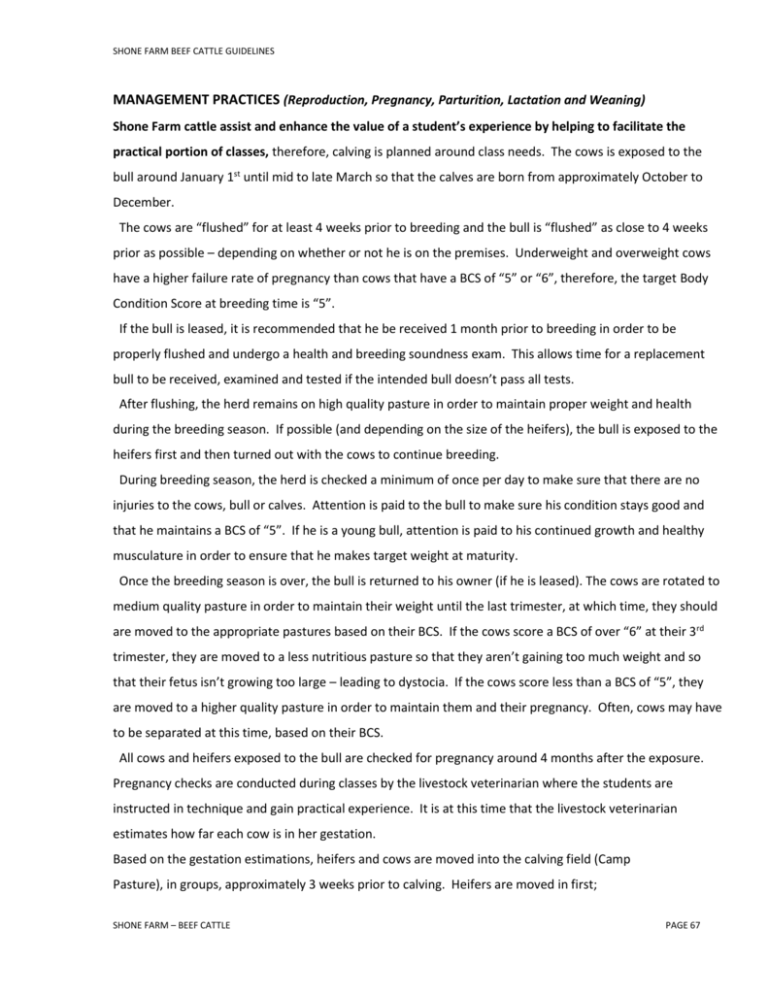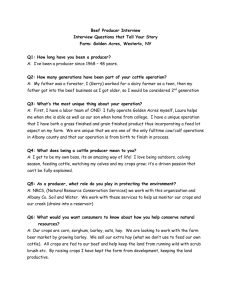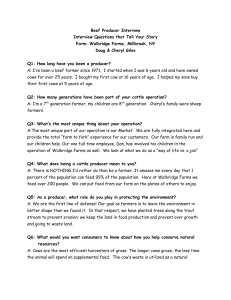Reproduction, Pregnancy, Parturition, Lactation and Weaning
advertisement

SHONE FARM BEEF CATTLE GUIDELINES MANAGEMENT PRACTICES (Reproduction, Pregnancy, Parturition, Lactation and Weaning) Shone Farm cattle assist and enhance the value of a student’s experience by helping to facilitate the practical portion of classes, therefore, calving is planned around class needs. The cows is exposed to the bull around January 1st until mid to late March so that the calves are born from approximately October to December. The cows are “flushed” for at least 4 weeks prior to breeding and the bull is “flushed” as close to 4 weeks prior as possible – depending on whether or not he is on the premises. Underweight and overweight cows have a higher failure rate of pregnancy than cows that have a BCS of “5” or “6”, therefore, the target Body Condition Score at breeding time is “5”. If the bull is leased, it is recommended that he be received 1 month prior to breeding in order to be properly flushed and undergo a health and breeding soundness exam. This allows time for a replacement bull to be received, examined and tested if the intended bull doesn’t pass all tests. After flushing, the herd remains on high quality pasture in order to maintain proper weight and health during the breeding season. If possible (and depending on the size of the heifers), the bull is exposed to the heifers first and then turned out with the cows to continue breeding. During breeding season, the herd is checked a minimum of once per day to make sure that there are no injuries to the cows, bull or calves. Attention is paid to the bull to make sure his condition stays good and that he maintains a BCS of “5”. If he is a young bull, attention is paid to his continued growth and healthy musculature in order to ensure that he makes target weight at maturity. Once the breeding season is over, the bull is returned to his owner (if he is leased). The cows are rotated to medium quality pasture in order to maintain their weight until the last trimester, at which time, they should are moved to the appropriate pastures based on their BCS. If the cows score a BCS of over “6” at their 3rd trimester, they are moved to a less nutritious pasture so that they aren’t gaining too much weight and so that their fetus isn’t growing too large – leading to dystocia. If the cows score less than a BCS of “5”, they are moved to a higher quality pasture in order to maintain them and their pregnancy. Often, cows may have to be separated at this time, based on their BCS. All cows and heifers exposed to the bull are checked for pregnancy around 4 months after the exposure. Pregnancy checks are conducted during classes by the livestock veterinarian where the students are instructed in technique and gain practical experience. It is at this time that the livestock veterinarian estimates how far each cow is in her gestation. Based on the gestation estimations, heifers and cows are moved into the calving field (Camp Pasture), in groups, approximately 3 weeks prior to calving. Heifers are moved in first; SHONE FARM – BEEF CATTLE PAGE 67 SHONE FARM BEEF CATTLE GUIDELINES MANAGEMENT PRACTICES (Reproduction, Pregnancy, Parturition, Lactation and Weaning) - cont regardless if they’re predicted date is later in the season because they may need special handling and care and they need to be watched more closely. The calving field is a large, clean area that is irrigated during the dry months so it always has grass. The level of nutrition in the fall/winter when calving occurs is such that it will support lactating cows until they move to a larger pasture with their calf. The proximity and accessibility of the Camp Pasture also allows for ease of movement of the cow or cow/calf to the barn in case of illness, injury or calving problems. Once cows are moved into the calving pasture, all cows are checked 3 times per day for new calves or signs of labor – regardless of where they are being kept. Gestation estimations are rough estimations that are never to be used as exact data - there are occasions when cows calve in the non-calving pasture. If this occurs, an attempt should be made to move the cow and new calf/calves into the calving pasture where they can be observed and where predators are least likely to be a problem. Calves are eartagged immediately upon discovering them or, if a birth is witnessed, as soon as possible thereafter. The longer a calf is left untagged, the harder it is to catch them, hold them and apply the tag. Ideally, a minimum of 2 staff members should attempt to tag a calf, however, there are occasions when the task can be accomplished by one person. Forethought and safety shall be employed at all times to avoid injury to staff and animals. Knowing where the dam is at all times and recognizing signs of aggression are paramount (see Behavior). Upon the birth of a calf, it should be monitored to make sure it stands and nurses and that the dam lets it and accepts the calf. The pair is then observed and care should be taken that they have bonded and the calf has received colostrum. If, at any time, the calf has trouble nursing (due to weakness, engorged teats or an unwilling dam, etc), the pair should be brought into the barn and housed in a pen together (as long as the dam is not aggressive toward the calf). If the teat is engorged with milk and too large for the calf, the cow is brought into the squeeze chute and milked down enough where the calf can nurse. The calf is brought to the side of the squeeze chute and encouraged to nurse. If the cow (usually a heifer) absolutely refuses to stand still for nursing – even in the pen – she should be brought into the squeeze chute so that her calf can nurse. If the calf is unable to nurse off of the cow while she’s in the chute, the cow must be milked into a bottle so that the calf can be bottle fed. If the calf is too weak to nurse off of its dam or the bottle, the calf must be tube fed. SHONE FARM – BEEF CATTLE PAGE 68 SHONE FARM BEEF CATTLE GUIDELINES MANAGEMENT PRACTICES (Reproduction, Pregnancy, Parturition, Lactation and Weaning) - cont A recording folder is kept with the ear tagging supplies at all times. The folder lists cows and calves with room to write notes next to each one. Notes should be written regarding any concerns, cow or calf behaviors and calving ease or difficulties. There is also a page where data concerning each calf (birth weight, color, number, dam) is to be maintained each time a new calf is born. Care should be taken to record accurate data in order for all staff members to be informed. Cow/calves should be moved in small groups to the Road Pasture (where the pasture is of high nutritional quality) during lactation after the calves are strong enough to do so and after there are at least 3 cow/calf pairs that can move together. Depending on the health of the cows and calves, they can be moved over as soon as when the calves are 4 days old, however, some will take longer. The Livestock Technician will observe and monitor the progress of the calves, with the help of staff, to determine when cow/calves should be moved to the bigger pasture. Regardless of where calves are located, they should continue to be checked 3 times per day for health and welfare. The Cow/Calf (Road) Pasture is closely monitored by the Livestock Technician to determine when the cattle should be rotated to another pasture. When pasture quality is low, the cattle will be rotated to West Pasture and may need to be supplemented with Orchard and/or Alfalfa Hay – depending on their condition and the condition of their udders and calves (see Nutrition). The cattle are rotated from pasture to pasture as determined by their condition and quality of the pastures. At times, it is necessary to have slaughter animals separate and on different pastures as they are prepared and finished for slaughter. During Lactation, the cattle herd is rotated to pastures of higher nutritional quality, if possible. If that isn’t possible, the herd should be supplemented with Orchard and/or Alfalfa Hay. When the youngest calf reaches 6 months of age, weaning of the calves should begin, providing all calves are healthy and close to 700lbs. Cows and calves are put in 2 different pastures that are separated by a high quality fence. This allows the animals to see and hear each other, which will prevent cows from wandering through fences searching for their calves. Ideally, the calves should be in the West Pasture on dry grass and the cows should be in the Hill Pasture or Coyote Pasture and being fed low quality hay. If the nutritional value of the pasture is too low to sustain the calves, they are to be supplemented with Alfalfa Hay in an area away from their dams. When the calves become independent of their dams and move further away from them to eat, the calves are moved to a high quality pasture and the cows are moved to a low quality pasture without supplementation as long as there is dry grass for them to eat. SHONE FARM – BEEF CATTLE PAGE 69 SHONE FARM BEEF CATTLE GUIDELINES ~ STANDARD OPERATING PROCEDURE ~ Reproduction, Pregnancy, Parturition, Lactation and Weaning Reproduction 1. Breeding cattle are “flushed” (provided with high quality feed) approximately 4 weeks prior to breeding 2. Bull is received 4 weeks prior to breeding and undergoes a quarantine period in the Porter Barn Beef Unit where he receives high quality hay 3. Bull has a health and Breeding Soundness Exam (see New Cattle) 4. Cows and Heifers are exposed to the bull on or around January 1st 5. Breeding animals and calves are checked a minimum of 1 time per day to make sure they are in good health and that there are no injuries 6. Bull remains with the cows and heifers until mid to late March 7. Bull is penned in the Beef Unit upon completion of breeding season to await transportation home 8. Bull recieves high quality hay until his departure Pregnancy 1. Staff assists the Livestock Technician in monitoring cattle for health and good body condition during pregnancy 2. Staff assists Livestock Technician in rotating cattle to different pastures as needed Parturition 1. One month prior to predicted calving, cows are checked a minimum of 3 times / day 2. Cows are monitored for any physical changes leading to parturition 3. The Cow Check Folder accompanies staff on checks so that any changes in the cows can be notated and so that staff can check off each eartag number as it is observed 4. When a calf is born, the staff member/s present make sure it is breathing freely, stands and nurses and is healthy 5. After a calf is born, it is eartagged as soon as possible (see Ear Tagging) SHONE FARM – BEEF CATTLE PAGE 70 SHONE FARM BEEF CATTLE GUIDELINES ~ STANDARD OPERATING PROCEDURE ~ Reproduction, Pregnancy, Parturition, Lactation and Weaning - cont Calving Observation & Response 1. If a staff member witness a calf being born, they should stay a good distance away so that the cow feels comfortable to lay down and get up in order to expel the calf 2. The staff member should notify the Livestock Technician (if on duty) of an impending birth 3. The staff member should notify other staff of an impending birth in the event assistance is needed 4. If, after the water breaks, the cow continues to struggle in labor for an hour, humane intervention most likely should occur 5. As the calf emerges, the staff member should observe the orientation of the calf (front feet and nose first) 6. If a staff member suspects a cow is suffering from dystocia, they should notify the Livestock Technician or Farm Manager as soon as possible 7. If the Livestock Technician and Farm Manager are unavailable, the Livestock Veterinarian should be notified (see Illness or Injury) for steps to be followed in an emergency 8. The cow should be moved into the Porter Barn so that she can be helped 9. Do not put the cow in the cattle squeeze chute to pull a calf 10. Follow the directions of the Livestock Technician, Farm Manager or Livestock Veterinarian on how to proceed with the dystocia Lactation 1. Cow/Calf pairs are checked 3 times per day until told otherwise 2. Cows should be observed for good body condition 3. Cows should be observed for good udder condition 4. Calves should be observed for good body condition, alertness and activity level 5. Calves should be observed nursing, grazing, eating hay and drinking water 6. If problems associated with lactation are observed or suspected, the affected animal/s should be brought into the beef unit and penned for observation (see Illness or Injury) 7. The Livestock Technician or Farm Manager should be notified of any Lactating issues Weaning SHONE FARM – BEEF CATTLE PAGE 71 SHONE FARM BEEF CATTLE GUIDELINES 1. During weaning, cattle are checked a minimum of 3 times per day 2. Animals are observed for good health and well being 3. Animals are counted daily to ensure none have gone through fences or left the property 4. Once weaning is completed, cattle are checked 2 times per day until the Livestock Technician determines it is no longer necessary Cow / Calf - Fall Calving System Pasture Hay Supplement Hay Supplement Hay Supplement Pre-Calving Shots Breeding Bull BSE Preg Check Weaning Jan Feb March SHONE FARM – BEEF CATTLE April May June July Calving August Sept Oct Nov PAGE 72 Dec SHONE FARM BEEF CATTLE GUIDELINES BASIC BEEF COW BIOLOGY Trait Optimum Target Birth Weight - Calves from Heifers 55lbs Birth Weight - Calves from Cows 60lbs Age at Puberty 13 - 14 months Weight at Puberty - Heifers 700 - 800lbs Weight at Puberty - Bulls ≈ 1,000lbs Gestation 283 Days Age at First Calving 24 Months Postpartum Interval to Breeding ≈ 90 Days Calving Interval 365 Days Calving Season ≈ 70 Days Reproduction SHONE FARM – BEEF CATTLE PAGE 73 SHONE FARM BEEF CATTLE GUIDELINES Growth & Nutrition SHONE FARM – BEEF CATTLE Mature Bull Weight - Avg Range 1,800 - 2,200 lbs Mature Cow Weight - Avg Range 1,200 lbs Dry Matter Intake - Late Gestation 1.8 - 2.3% of body weight Water Intake - Nonlactating @ 85°F ≈ 1 gal / 100lbs body weight Water Intake - Growing or Lactating @ 85°F ≈ 2 gal / 100lbs body weight Weaning Weight - Steer @ 7 Months ≈ 600lbs PAGE 74 SHONE FARM BEEF CATTLE GUIDELINES Beef Cattle Shone Farm: Shone Farm: Livestock 7450 Steve Olson Ln Forestville, Ca 95436 1-707-535-3700 Leonard Diggs Farm Manager 1-707-535-3702 ldiggs@santarosa.edu Livestock Guidelines Management Guidelines Beef Cattle Beef Cattle Rough Draft: Attention Leonard Diggs Company profile SHONE FARM – BEEF CATTLE Beef Cattle are raised at Shone Farm to assist and enhance the value of a student’s experience by helping to facilitate the practical portion of classes as well as for customer sales and processing for sales. The number of animals kept on the premises is based on class needs, customer needs and the needs of Shone Farm regarding reproduction and processing for consumption and sales. Shone Farm has approximately 100 acres of grazing land for Cattle and other livestock: Irrigated acres = 60 and Dry acres = 40 PAGE 75



